


































Volume 19 • Number 2

Published twice annually
A Publication of Newspaper Media Group
Arlene Reyes
ART DIRECTOR
Terri Saulino Bish
DIRECTOR OF ADVERTISING
Tish Kraszyk

SENIOR ACCOUNT EXECUTIVE
Ron Kraszyk

CIRCULATION
Luis Vasquez
FINANCIAL
Sharon Metro
Jersey City Magazine is published by the Newspaper Media Group, 166-168 Broadway, Bayonne, New Jersey 07002, (201) 798-7800, Fax (201) 798-0018. Email bayonnemag@ hudsonreporter.com. Subscriptions are $10 per year, $25 for overseas, single copies are $7.50 each, multiple copy discounts are available. VISA/MC/AMEX accepted. Subscription information should be sent to JCM Magazine Subscriptions, 166-168 Broadway, Bayonne, NJ 07002. Not responsible for unsolicited manuscripts or other unsolicited materials. Copyright ©2020/21, Newspaper Media Group. All rights reserved. Reproduction in whole or part without written permission is prohibited.
Jersey City Magazine is a publication of Newspaper Media Group 166-168 Broadway, Bayonne, New Jersey 07002 phone 201.798.7800
DANIEL ISRAEL is a writer and videographer. He first set foot in Bayonne in 2018. Ever since, his life has centered around the city. When he’s not working, Daniel enjoys relaxing in 16th Street Park and visiting Bayonne’s coffee shops and eateries.


VICTOR M. RODRIGUEZ has studied photography, publication design, and graphic arts. “I’ve been fascinated by photography for 20 years,” he says.
MAXIM RYAZANSKY is a photographer whose work has been exhibited in galleries and published worldwide. A recent transplant to Bayonne, he spends his spare time trying to figure out the best pizza place in town.
TARA RYAZANSKY is a writer who moved from Brooklyn to Bayonne. She works as a blogger for Nameberry.com and spends her spare time fixing up her new (to her) 100-year-old home.

is the art director for The Hudson Reporter’s award-winning magazines and newspapers. Her work includes capturing many of the iconic photos featured in print and online across Hudson County.
TARA RYAZANSKY
DANIEL ISRAEL VICTOR M. RODRIGUEZ MAXIM RYAZANSKY






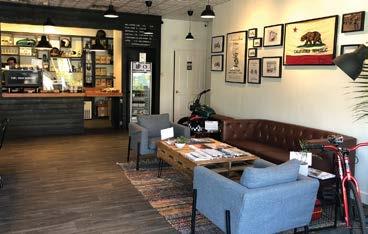


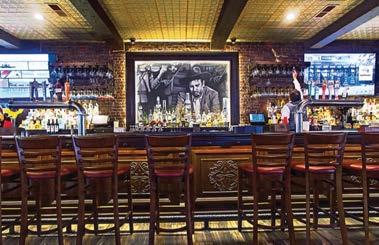





Make an appointment today...We will give you a reason to smile.

Giorgio T. Di Vincenzo, DMD & Associates
VOTED NEW JERSEY MONTHLY MAGAZINE “TOP DENTISTS IN 2011-2021”
Giorgio T. Di Vincenzo, DMD
David J. Lefkowitz, DDS

Edward J. Chang, DDS, MS



Board Certified in Periodontology and Implant Surgery
------ Dr. DiVincenzo ------
Place Your Trust in a Periodontal Surgeon with over 30 years of experience in Dental Implant Surgery, and Periodontal Issues

Latest Techniques in Minimally Invasive Aesthetic Gum Grafting
We also offer Periodontal Laser Surgery No Referral Necessary
Clinical Assistant Professor at NYU
Director of Periodontology at Staten Island University Hospital/Northwell
MOST DENTAL INSURANCES ACCEPTED | FINANCING AVAILABLE



The all-on-four® approach which refers to all teeth being supported on four dental implants completely rehabilitates a compromised arch with a non removable prosthesis. This approach can be performed on either the top, bottom or both jaws. A Surgeon and Prosthodontist or a highly trained Restorative Dentist allows you to leave with the smile you always wanted ... THE SAME DAY
For Accurate Planning of Implant Surgery, Sinus Elevation, and Bone Grafting Procedures.





SEND

Rock The 21 hosted their Blue and Gold Gala fundraiser on October 29.
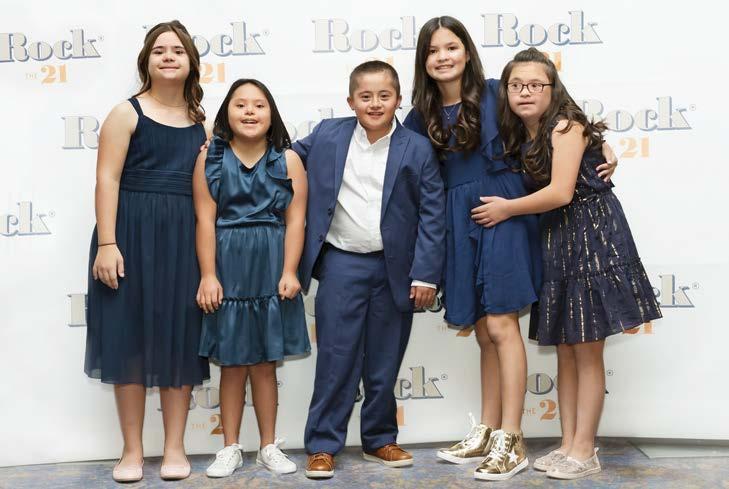
Rock The 21 is a non-profit corporation dedicated to supporting individuals with Down syndrome and their families.

rockthe21.org


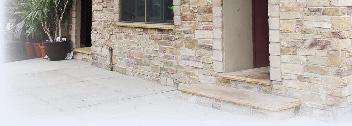
see more page 12

Starting a family, when you’re having difficulty ge ing or staying pregnant, may feel overwhelming, even scary at times. But you don’t have to feel this way. For more than twenty years, RMA New Jersey’s compassionate fertility specialists and an 83.3% birth success rate have helped put more than 50,000 babies in to the arms of loving parents.
810 out of
83.3% individuals who visit RMA New Jersey make their vision of parenthood a reality.
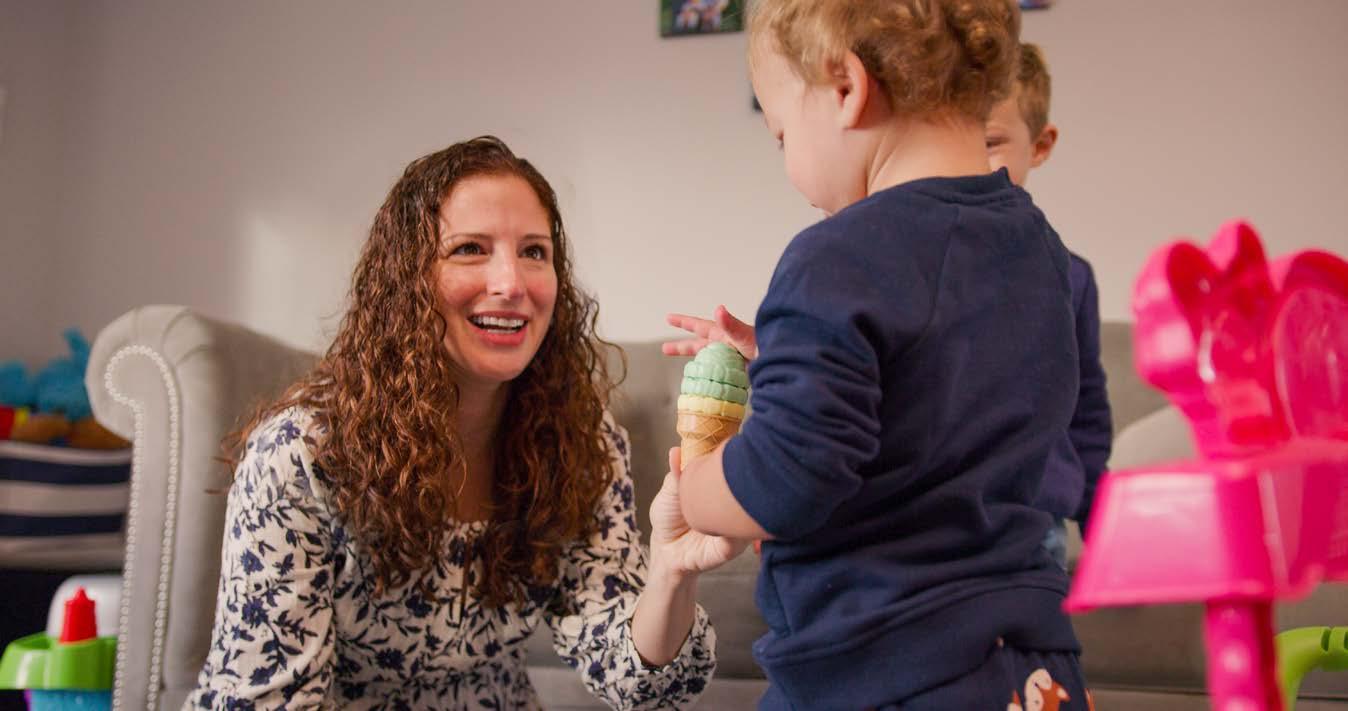
time,
RMA’s Live Birth Rate in women under 35 years*











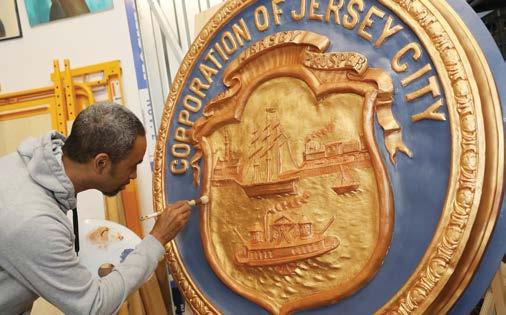

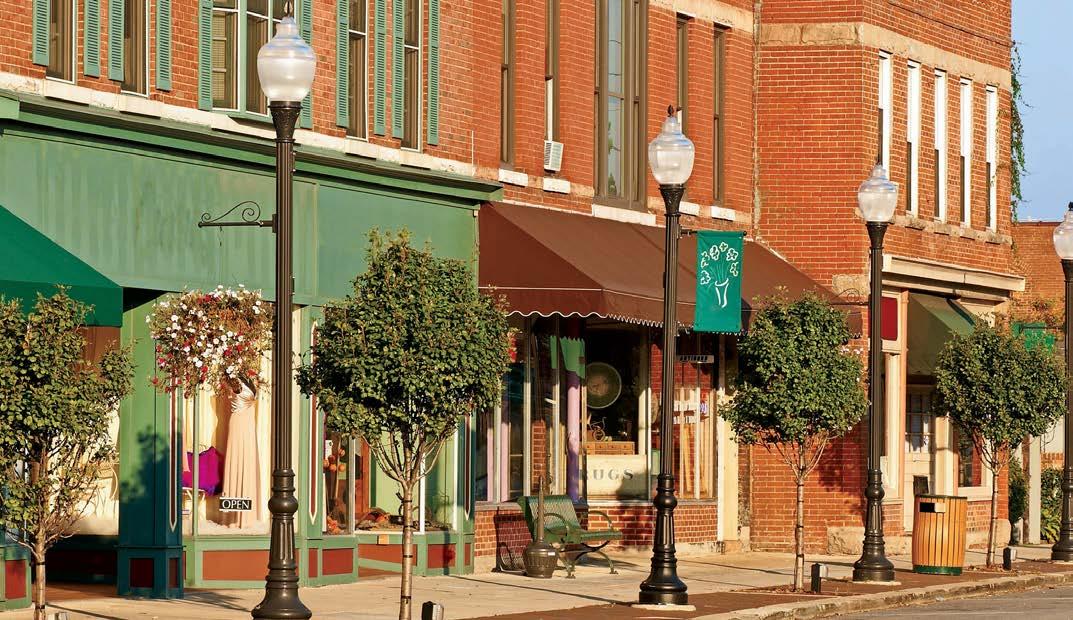
Story and Photos
by Daniel IsraelKate Rounds has worked in the media industry for much of her life, but has always wanted to be a published author. Now, the longtime Jersey City resident has fulfilled that dream after the
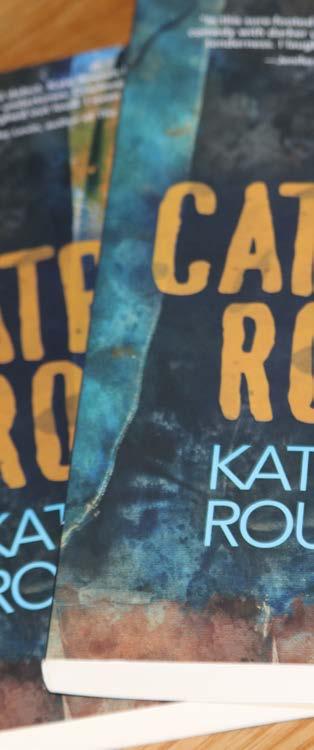

publication of her first novel entitled Catboat Road
Kate said she vividly remembers the first time she wrote something as a child.
“I can remember the first story I wrote,” she said. “I was about 5. It was about a blade of grass that got murdered by a lawn mower. What I remember most is that I asked my

dad, ‘What does this mean?,’ like I was trying to get some contextual analysis.”



While keen on creative writing and the like, Kate decided to pursue journalism to make a living. Rounds was the Editor-in-Chief of Jersey City Magazine, as well as other Newspaper Media Group publications includ-
ing the Hudson Reporter, the Bayonne Community News, Bayonne: Life on the Peninsula Magazine and 07030 Hoboken Magazine for the last 15 years. Prior to that, she was a Senior Editor at Ms. Magazine, where she served as Gloria Steinem’s editor, and worked five years as a Speechwriter and Executive
Editor at the Planned Parenthood Federation of America.
“I’ve always wanted to write fiction and, like a lot of writers, I ended up doing two things that you can do to make a living,” she said. “One of them is journalism, and the other is teaching literature. When I was young, I thought journalism was exciting, so I chose journalism.” While Kate opted for a career path in the news industry, that didn’t stop her from writing fiction.
“It’s taken me this long not to write a book, but to get anybody to pay attention to it to get it published,” she said. “Many authors have written tons of novels over their lifetime, but they never see
the light of day. That’s true for me, too.”
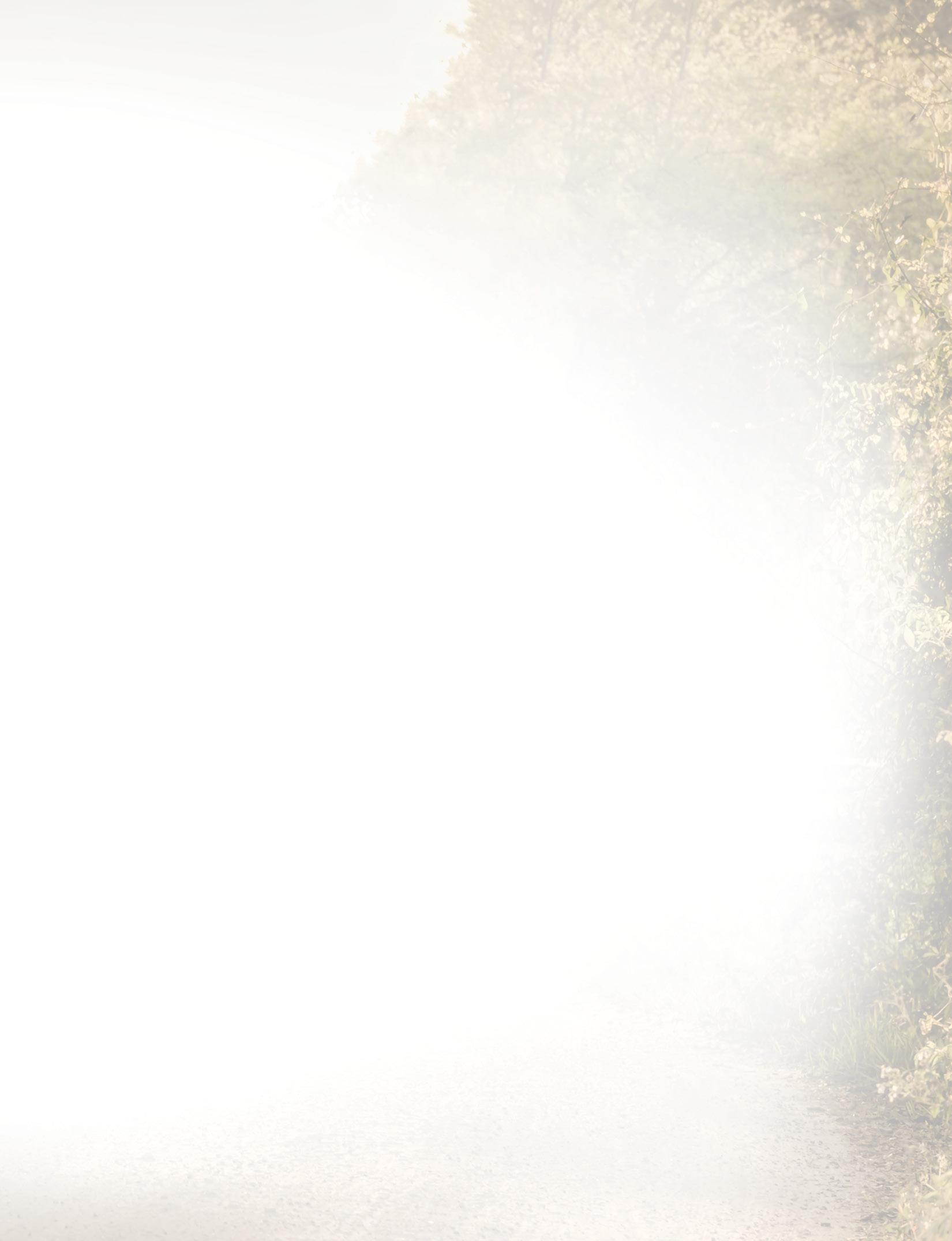
Kate has been working on Catboat Road since 2015, and is now finally able to have it published by Bywater Books.
“This book I remember I started on December 15, 2015,” she said. “So it took me from 2015 to write it and to get an agent and a publisher and the whole thing. Getting an agent and publisher took longer than writing it.”
Without giving too much away, Kate gave a brief summary of Catboat Road: “The book is pretty easy on the surface. It’s about a teenage lesbian who falls in love with

her mother’s best friend. It’s about how that plays out. I won’t give away any spoilers, but it ends in a way that probably most people wouldn’t expect. Let’s put it this way, nobody goes to the slammer.”
According to Kate, the book was inspired by a conversation she overheard as a teenager.
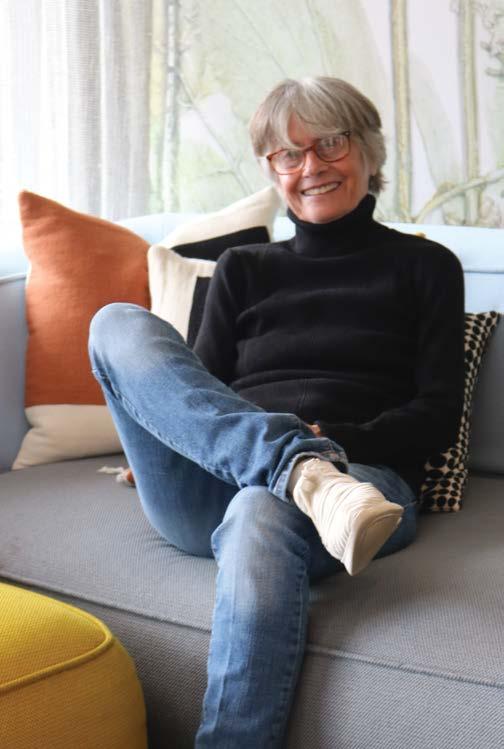
“For some reason, this stuck in my mind,” she said. “My brother and I were eavesdropping on my mother and her friend. Her friend was crying, and it’s a big deal for younger people when older people cry, right? She was crying because her husband had left her, but something about that scene of her crying made me think it would make a good story.”
The book stems from that memory from her formative years, setting up the start of the story.
“So the way the book starts is with kids eavesdropping on the stairs,” she said. “It stems from that memory I had as a teenager.”
Catboat Road is the first book of many that Kate plans to have published. She is also exploring writing short stories.
“I’m working on another book now,” she said. “I don’t think I could ever make a living as a novelist. Not a whole lot of people do, only the cream of the crop. I don’t
think I could ever do that, but I’m always going to want to write novels. It’s what I want to do most.”
The shift from writing hard news to penning fiction novels has been a welcome change for Kate.
“Being a journalist my entire life, it’s very freeing not to have to stick to the facts,” she said. “I know journalists have a bad name, everybody thinks we never stick to the facts. But even in a small publication like we’ve been working on, we stick to the facts. You get in trouble if you don’t.”
Kate still writes occasionally, too, including for major publications like the New York Times. On top of becoming a published author, she has started teaching literature.
“I’ve been a journalist, I’ve been a novelist, and the opportunity came to be, what they call me now, a ‘prof,’” she said, noting that the title makes her laugh, “I said why not? It’s sort of like a three-legged stool. You’re a journalist, you’re a novelist, and you’re a teacher. I’m absolutely new at this teaching thing, but I’m very challenged by this idea that I would love these kids to leave the class knowing more than they did when they went in and hopefully to be inspired by what all us journalists and writers are inspired by, which is what you can do and say with words. It never ceases to amaze me.”
Kate is now a professor in the Writers Studies Department of Saint Peter’s University.
“It’s a fabulous Jesuit small college, which of course made big news during March Madness when they made it to the Elite Eight, and my ex-
perience with everybody here has just been great,” she said. “Saint Peter’s has just been great.”
Currently, the course Kate teaches is focused on fiction, but she is looking to get into creative writing.

“It’s what other people would call literature,” she said. “We read books and we talk about books.”
Amid the changes in Kate’s life since she stepped away from her journalism career to pursue these other endeavors, she also moved from her garden apartment to a newer mid-rise apartment. However, she has remained in Jersey City, a city she has long called home.
“I’ve lived in Jersey City for a very long time,” she said. “I feel I don’t even know the exact date, but I think it was around 1989 or 1990 when I first moved here.”
For some time after she first moved to Jersey City, Kate lived on a boat in the nearby waters.
“I’ve seen enormous changes here, because from around 1993 to 2007, I lived on a boat in Liberty Harbor Marina, which was a great experience,” she said. “It’s kind of a village unto itself, when you’re living on a boat. Imagine what I’ve seen. Back in those days, you could just walk around literally on the river bank. Now you can’t, it’s all closed in. Back then, there were no high rises.”
While Jersey City has changed, so has Kate, and she still has a big space in her heart for the city.
“I love Jersey City,” she said. “You couldn’t pay me to live in Manhattan or Brooklyn, although I have lived in Manhattan before. Now I spend a lot of time visiting in Manhattan, and when I come back to Jersey I feel it’s so much more peaceful here. I just think Hudson is a great county.”
Kate highlighted how the city has become an epicenter for arts and culture.
“It’s important for people who are involved in the arts, whatever that may be, whether it’s writing, painting or music, that Jersey City is a real hotbed for people involved in any kind of cultural events,” she said. “Obviously COVID-19 put a damper on tons of stuff, but there’s so many musicians, writers, artists living here. I think it’s a great place for people who are interested in that kind of thing.”
According to Kate, living in Jersey City has not only been a great outlet for creatives, but has influenced her life and writing.
She concluded, citing formative years on the boat in the Liberty Harbor Marina: “I could have stayed in New York, but I wouldn’t have had the experiences that I’ve had here in Jersey City.”— JCM
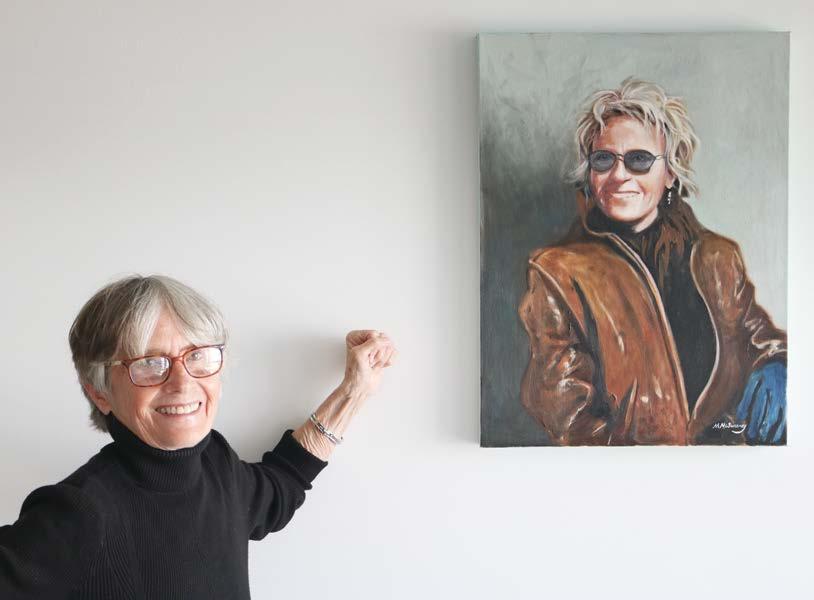























Violet Garritano has always been fascinated with the potential of the human mind. “You know how they say that we can only access a certain portion of our minds? It’s something like 10 or 20%. Even in high school, when I was a kid, I would think, ‘What would happen if we could access all of our minds?’ What would happen if we could control our subconscious mind?”
Garritano has devoted her career to helping people reach their potential by guiding their subconscious mindsets. She is a clinical hypnotherapist who is certified by the International Board of Coaches and Practitioners. She says that a hypnotherapist is someone who utilizes hypnosis for therapeutic intervention.
“I explored hypnotherapy for my own personal development,” Garritano says that she wanted to use hypnotherapy to manage anxiety. “I wanted to learn how to truly regulate my nervous system. How can I really control my mind and access

my mind? How can I gain a deeper understanding of where this anxiety is coming from? Hypnosis is designed to really reprogram the mind.”
Now, she uses hypnosis to help herself and others.
“People will come to me with issues like they want to lose weight or they want to stop smoking or they want to release a fear, but because everything is so dynamic, it’s never just that. Let’s say someone has a problem with overeating. We would look into when did this start? Why do you overeat? What void are you trying to fill,” Garritano explains that her clients end up learning a lot about themselves. “It’s almost like this beautiful self-discovery work that we do. I ask questions to get to the root cause of it so that when we do undergo a hypnosis it’s very thorough work. You get better results this way when you get to the root cause.”
Garritano says she starts off a session by educating new clients about what she does.
“I always do a little demystifying of hypnosis because a lot of people have misconceptions. Some of them include
that hypnosis is mind control. The reality is that hypnosis is not mind control. If you wanted to actually brainwash someone, and this is the actual definition, you would have to deprive them of sleep. You would have to implement some sort of pain/pleasure response, and then you would have to change their biochemistry. Hypnosis does none of those things. It’s definitely not brainwash,” she says, adding that another misconception is that the client will be asleep and not remember the experience. Garritano says that it is a trance state rather than a sleep state and that everyone is different regarding whether or not they remember the experience.
But Garritano says that there is one thing that’s the same about all of us.
“Every single person can be hypnotized. It’s just a matter of their willingness. If you’re going to come into this saying, ‘This is BS. This is a hoax.’ Then those are the results that you’re going to get. I forget who said it, but there’s a quote that goes, ‘If you believe you can, you will. If you believe you can’t, you’re also right.’
If someone doesn’t believe in themselves enough to accomplish a goal because all hypnosis is self-hypnosis, they’re not going to get those results. Everybody can be hypnotized, but not everyone is open to it.”

If you are open to it, Garritano says that most sessions follow a certain format.
“A typical session would look like this; I would meet a new client, and we would talk a little bit about their history. Everybody is different, so you can’t treat everybody the same. Everybody has different desires, different wounds, different traumas, things like that, so I spend the beginning of a session getting to know people,” Garritano says.
Next, Garritano incorporates Reiki, which is an ancient form of Japanese energy healing. She says this helps clients feel relaxed and safe before the hypnotherapy begins. She also coaches the client through positive affirmations at this time. Then the hypnosis begins.
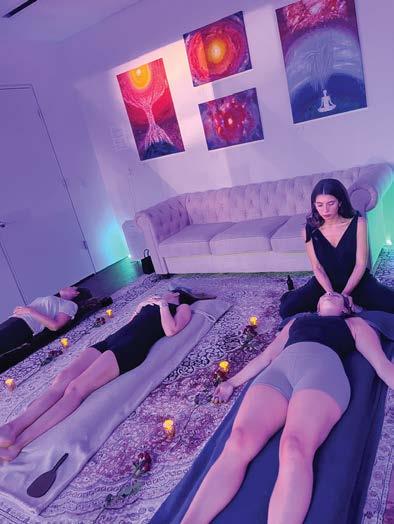


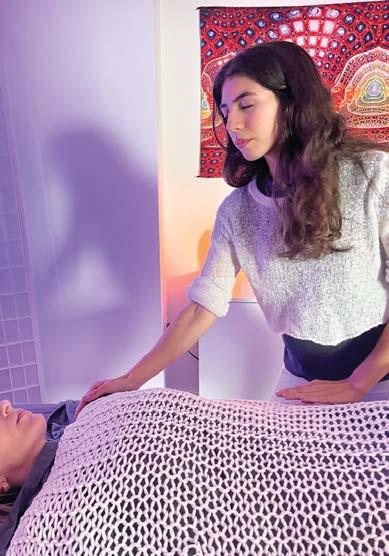



“They lie down, they close their eyes, they don’t have to do anything, they just have to listen to the sound of my voice, and as they’re listening to the sound of my voice, I bring them into a hypnotic trance with a series of relaxation techniques,” Garritano says. “Then the therapy portion
begins. That’s when we do the real subconscious reprogramming. That’s where essentially you’re taking your power back and disregarding all of your past and why you couldn’t do the things that you wanted to do in the past, and just moving forward cause there’s nothing you can really do about the past, but you can do something about the present which creates your future. That’s what we work with.”





To close out the session, Garritano talks to the client about their experience. She says that some clients have a lot to say, while others just want to go home and process the experience. “This is actually a direct quote from one of my clients; ‘I feel like I went through a couple of years of therapy in this one session.’ It’s intense work,” Garritano says. She warns that the work she does with clients isn’t for everyone. It’s for people who really want to make a change in their lives, which is often difficult and disruptive. “Not everybody is in a space where they want to start deconstructing the reality that they’ve made for themselves. You really have to be ready to take your power back with this kind of work. It takes a warrior to do that. You have to be ready to meet yourself so deeply.”
Garritano sees clients at Ohm Life, where she is the director. She also does house calls and virtual appointments.



“I want to make sure that I’m accessible, so I do group sessions,” Garritano says that these themed monthly workshops are a great first step to trying hypnotherapy. “The next one is designed to help you get in touch with your inner self. I might do a hypnosis to help someone feel safe enough to be themselves or for forgiveness for neglecting their true selves. We say ‘Be your best self.’ but we have to feel safe enough to do it. At these workshops, everyone is coming together with the same intension, so the energy is so powerful.” — JCM

Photos courtesy of the Phyllis Greer
Have you heard about the many Bigfoot sightings in Jersey City? The creature has been spotted all over town. It was seen near Van Vorst Park, and a few days later, it was lurking by Clinton and Bergen Avenue. I decided to investigate and noticed that every sighting occurred near a branch of the Jersey City Public Library. Was it a coincidence?


Library director Terry B. Hill confirms that it isn’t, “We call it JC Bigfoot. He or she is at a lot of events that we have out in the community. It’s a first for the library to have a mascot. It seems to be pretty popular. It’s a bright blue mascot with kind of a goofy grin on its face.
The kids seem to enjoy it.”
You can keep up with JC Bigfoot on social media too.








“On our Instagram, there are usually around two posts a week featuring the adventures of JC Bigfoot. It’s an animated series that one of our staff members is doing,” Hill explains. You can see the comics by following @jclibrarynj.
Hill says that JC Bigfoot is a part of a larger effort to get more community members interested in the library.
“We launched a campaign back in April called Power in Your Pocket,” Hill says.

This campaign involved sending staff members into the community at local events or simply on the street outside of library locations. They approached passersby to
educate them about the power of having a library card in your pocket.
Hill says that since the beginning of the campaign around 10,000 Jersey City residents have signed up for library cards. He adds, “Those are people who have never had a library card here before.”
Signing folks up for a library card isn’t a very tough sell. “With it, you have access to all of our printed materials, of course, but there are so many resources that we provide access to for free,” Hill says. “There are things that would cost an individual thousands of dollars to get access to. We want people to see the value of having a library card and all that’s available to you with that one card.”
This includes live homework help, resume help, and









various classes that range from toddler storytime to computer help for senior citizens. Cardholders can also borrow from an extensive ebook collection and browse downloadable and streaming films and television shows via the Hoopla app.
“We loan hotspots out to the public. People can check those out for, I believe two weeks. They can have that access to the internet and connect their device to it,” Hill says, adding that if you don’t have a device of your own, they can help with that too.

“We have kits that we’ve put together where you can check out a laptop and a hotspot so that you have the internet access and a computer.”
Hill took on the role of director of the Jersey City Free Public Library last year.
“I’ve been working in libraries for 28 or 29 years. My very first library job was when I was an undergrad in college. I got a part-time job at the library and just kind of stuck with it,” Hill explains. At the time, he studied music and was completing a degree in Sociology in North Carolina. He never imagined that he would have a career in the library. “You know how plans go. They change sometimes.”
For a while, Hill worked in academic libraries, but he felt called to switch to public libraries.
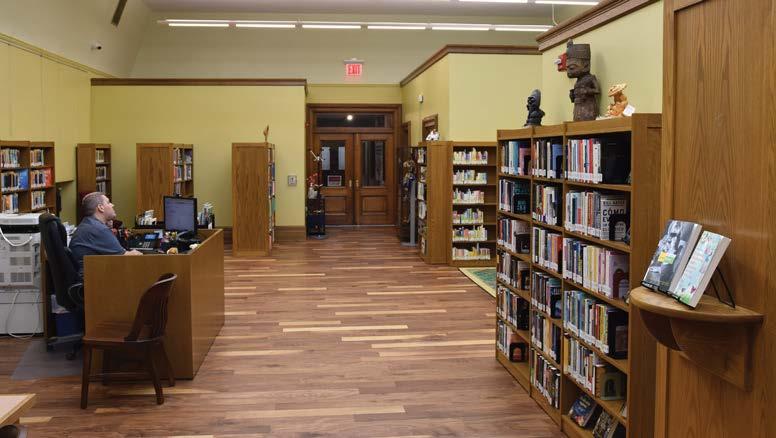
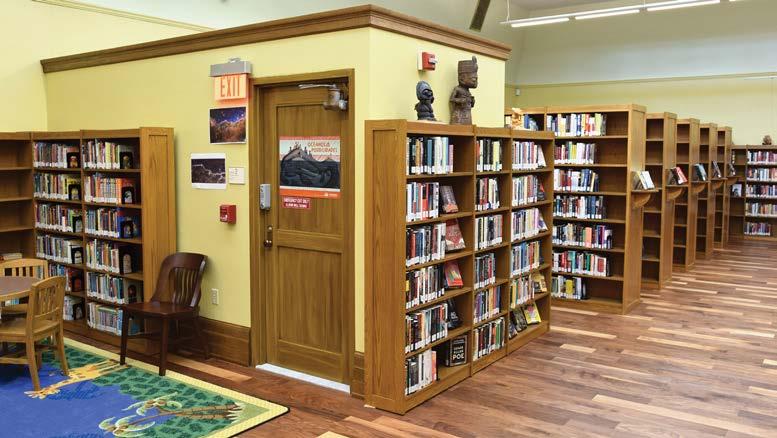
“I was doing a lot of community service work at the time for Guardian ad Litem as a court advocate for abused and neglected children. I did that for a number of years,” Hill would go from hearing about difficult custody situations to the academic setting on campus. “The thing that people would complain about there, there was such a divide. It was like living two lives or something.”

Hill switched focus and worked as deputy director at the Durham County Library for almost ten years.
“Once I got into public libraries, even though I wasn’t working directly with the public, it all seemed to align. Even if I was sitting in meetings all day, the work that I was doing had a direct impact in the community that I lived in. That’s what really sold me on public libraries,” Hill says.
“When the position became open here in Jersey City, I applied and was fortunate enough to be chosen,” Hill says, adding that Durham is also a diverse community with a large library system, but Jersey City is just a bit bigger and more diverse. “Having Raleigh next door to you is nowhere near like having New York City next door to you.”
As Hill heads towards his one-year anniversary as a Jersey City resident and in his position as director, he looks forward to some exciting library events.
“We will be celebrating the 100th anniversary of our Miller branch on November 5th,” Hill says that the branch’s jazz band in residence will be performing. “There’s a lot of history in that branch, not just because of the age of it, There have been some notable jazz performers come through over the years as well as community activists. We’re looking forward to celebrating the Miller Branch.”
As a part of Hispanic Heritage Month this fall, the library is also celebrating the 50th anniversary of Biblioteca Criolla. This collection is like a library within the Gardener Main Library that has original and translated Spanish language books and resources for patrons of all ages. The celebration on October 8th will include food, performances, and book signings in the newly renovated space.
Hill encourages the public to come out to these events and sign up for a library card if they haven’t already. You might just have a JC Bigfoot sighting of your own too.
— JCMTheBoys and Girls Club has created a space for young people for over 150 years.





“What The Boys and Girls Club is, besides being a safe and enriching, nurturing wonderful place to go to and grow up at, it’s a place where kids can participate in a myriad of programming from education, career development, the arts, the sciences, STEM and so on and so on,” says Executive Director Gary Greenberg. “What we really do is prepare our kids to be productive adults in
society. We provide kids with the opportunities that prepare them for their future.”The Boys and Girls Club of Hudson County, which is licensed as a childcare provider, has programs for kids from 4-18 years old, though Greenberg adds that some kids have continued with the club into adulthood by joining the staff.
“It’s a fun environment designed to offer incredible, intriguing, captivating activities,”

Greenberg says, listing photography, videography, visual arts and much more. “And, of course, we have sports. We have nice gymnasiums in our club, so the kids participate
in physical recreation every day.”
The Jersey City flagship clubhouse is located at 225 Morris Blvd. at the Marin Boulevard Light Rail station. The club also serves children at PS 15 and PS 41 and at Marion Gardens.

“We’re the youth services provider for the Jersey City Housing Authority. They’re wonderful to partner with. It gives us the opportunity to serve kids we might not ordinarily be able to reach,” Greenberg explains. “We have a clubhouse location in
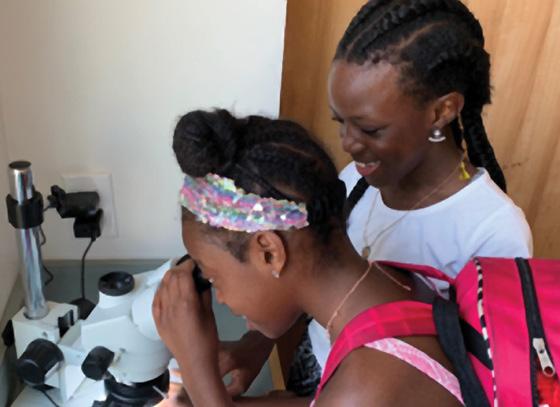
Marion Gardens in a beautiful community center that the housing authority renovated.”
The club provides afterschool transportation to its main location by walking or busing kids from area schools.
“Every kid is eligible. We want to include everybody from every part of the city,” Greenberg says. “It’s a very diverse, eclectic, incredible mosaic. It’s a wonderful thing to see. The wonderful part of it is that kids get to meet each other and grow up with kids from other neighborhoods that they wouldn’t ordinarily meet, in an enriching setting. It’s fantastic, and these kids become friends for life.”
Greenberg says that the variety of activities opens the clubgoers up to things they otherwise might not ever experience, and it’s often surprising how excited they are about these activities.
“We have a garden at 95 Morgan St. on the corner of Washington Boulevard,” Greenberg says. “It’s filled with vegetables and fruits from corn to watermelon and everything you can possibly think of. It’s in 48 beds that we had volunteers make. These kids were introduced to it when COVID hit because
we couldn’t take the kids on field trips because they couldn’t be confined in buses. At the time, our kids had no experience with something like farming. They had never done planting. They were not exposed to anything like that. You would think the kids would say, ‘Oh, I’m not doing that.’ But the kids are into it. We transformed a flat piece of nothing into an oasis.”
The Boys and Girls Club expands kids’ horizons beyond Jersey City. One important initiative brought Boys and Girls Club teens to Trenton.



“It used to be that if you were suicidal or needed urgent care or counseling, you

needed to be 18 or above to go and do that on your own. You couldn’t do it without parent consent,” Greenberg says. “Many times, the kids are suffering, and it might be something due to the parents or the household. The Boys and Girls Club Keystone group campaigned for two years and got support for the legislature down in Trenton.
On Christie’s last day as governor, he signed the bill, and it’s called the Boys and Girls Club Keystone Law. It allows kids ages 16 and older to now seek counseling and help. All these years later and it hasn’t gone away. Now, we have support to possibly bring the
age lower to 13, which is what we originally wanted.”
The Boys and Girls Club also helps kids apply for college. They have taken trips to visit university campuses in places like Boston and Washington, D.C.
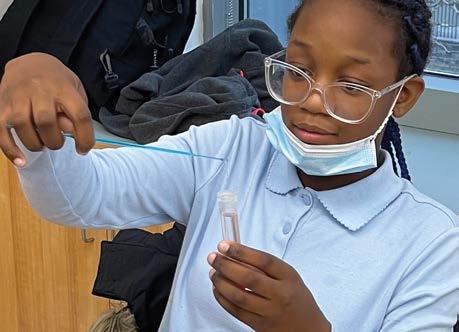

“Your imagination can only take you so far,” Greenberg says. “Unless these kids get to see something like that, how can they dream it? That’s what the Boys and Girls Club is about.” — JCM
Visit bgca.org
Photos courtesy of the Ukrainian National Home and Ukrainian Jersey City
InFebruaryof 2022, a large-scale war broke out in Europe for the first time since the Balkan Wars in the 1990s. The Russian Federation, at the behest of dictator Vladimir Putin, launched an invasion of Ukraine to support and eventually annex separatist areas in the eastern portion of the country propped up by the Russian government.
Since then, the war has shifted through many phases, from Ukraine being on the defensive to now launching a counteroffensive against the Russian occupiers. As fighting between Ukrainians forces defending their homeland and the Russian invaders continues, many are impacted by the war, not only in Ukraine but across the world, even in Hudson County in New Jersey.
Two nonprofit organizations in Jersey City have been at the forefront of local efforts to aid Ukrainians devastated by the war abroad and refugees fleeing the wartorn country that have made it to safety in New Jersey. Leaders from both organizations spoke with Jersey City Magazine about their initiatives to help those impacted by the Russian war in Ukraine to the best of their abilities.
Olena Halkowycz is a member of the Board of Directors at the Ukrainian National Home. The nonprofit organization has deep roots in Jersey City, having celebrated its 100th anniversary in 2018.

“The Ukrainian community in Jersey City has been organized into the Ukrainian National Home since 1918,” Olena said. The nonprofit hosts festivals, picnics, celebrations and easter egg paintings each year.
The Ukrainian National Home also provides a space for member organizations to operate in, including things like youth organizations, dance groups and a women’s organization. Specifically, the facilities are used by local branches of the Ukrainian Congress Committee of America and the Organization for Defense of Lemko Western Ukraine as well as local nonprofits including Ukrainian Jersey City, among others.
The Ukrainian National Home and many of the organizations it supports have been active in Jersey City for quite some time. Since the start of the invasion, the Ukrainian National Home has shifted gears from hosting cultural events to providing support for those affected by the war, led by Humanitarian Project Director and member of the Board of Directors for the Ukrainian National Home Wasyl Nikolyn.
“Now not only do we focus on cultural events, we also focus on current events and fundraising,” Olena said.
The support for Ukraine by the Ukrainian National Home in part translates to antiwar activism. The organization has coordinated multiple trips to protests in major cities across the United States to vocalize against the Russian war in Ukraine.
“We also try to organize the community to join a protest in New York or a protest by the Russian embassy in Washington, D.C.,” Olena said. “We’ve organized two bus trips to Washington, D.C. We include Jersey City into the national activities here in the United States.”

For months, the Ukrainian National Home has been collecting donations of necessities to ship to Ukrainians in need overseas and refugees who made it to Jersey City. Efforts are slowing now, but
the organization is still collecting donations from anyone looking to help.
“We are winding it down over time, especially now with the tragic weather events that are happening,” Olena said. “We turned down the fundraising, and when you do that you will also affect your shipping abilities. It’s expensive to ship. So as we’re winding down the collections, and the funding is winding down, we’re shipping over the last supplies.”
The supplies currently being collected and distributed to Ukrainians abroad are mainly winter clothing items and other essentials. Olena said the community has been generous with their donations at such a pivotal time.
“We provided help until the tail end of the winter last year, and this year we’re looking for whatever we have left, the coats, the socks, the hats and the gloves, and we’re sending that out,” Olena said. “We’re sending baby products out. Health and beauty aids, we’re sending that out. I can’t even tell you how the community in both Jersey City and Hudson County came through.”
There has been a groundswell of support from not only Jersey City, but all of Hudson County, Olena said. The efforts to help Ukraine extend beyond the local Ukrainians primarily living in Jersey City as well as Bayonne.
Olena continued: “We have the police association supporting us. We have teachers in schools supporting us by teaching current events and holding fundraisers with parents. We have the business community supporting us, and most of them were not Ukrainians. They just understood the need, and they understood the horror and the tragedy of the people.”
Jersey City community stands united for the Ukrainian cause
Many types of people from all different creeds have lent a hand in some way, shape or form, according to Olena. The war has united many people from all walks of life in support of Ukraine.
“It’s not only the regular community, the teachers, the unions, but the clergy and
the religious organizations, be they synagogues or churches or mosques,” Olena said. “People of all religions have come through to help us. We had humanitarian and spiritual support at our events. We had people from different denominations, different religious organizations, and they came to help us. They prayed with us, they supported us.”
Olena said the hyperlocal community near the Ukrainian National Home’s location has been beyond supportive, including people who live on Central Avenue and Palisades Avenue who walk in with donations. The overwhelming support is encouraging, she said, as the war is no longer at the top of everyone’s minds as it was when Russia first invaded.
“The tragedy in Ukraine is not reported as much as it was,” Olena said. “The tragedy did not lessen, it actually got worse because the lands that the Russian government occupies are really torture chambers.”
The state of the war has intensified as Russia has announced annexation of parts of the Russian-backed separatist territories of Ukrainian following a sham referendum. Olena said people living in these territories that are being forcefully made a part of Russia are being heavily oppressed.
“People are forced to say they are Russian,” Olena said. “There is a door-to-door campaign and you don’t tell somebody you don’t want to be Russian because that’s trouble. The men are being drafted to fight against Ukraine. Some were taken to Russia proper. It’s tragic. People are shipped by the thousands to Russia and dispersed throughout the land so they can be workers. It’s torture. They were evicted from their homes and shipped over to Russia.”
According to Olena, much of the worst things happening in the war are not heavily publicized, and the longer the war continues, the worse the situation gets for Ukrainians. She hoped that more awareness can be raised of the atrocities brought on by the Russian war in Ukraine.
“It has happened in the past after World War II, when refugees were forced to take trains to go back to their homeland, but they never went to their homeland,” Olena said. “They were taken to Siberia and into the work camps and gulags. Somehow, there’s a low profile on this stuff that’s going on and it’s not good.”
Olena hopes not only to raise more awareness on the impacts of the war, but to keep people’s attention as winter approaches. That will be a critical time for Ukraine.
“Now that winter is coming, the food situation is poor,” Olena said. “The logistics situation is poor. The structural damage is everywhere with the fallout from all the shelling and the explosives, and the mines that have been set up everywhere. They just continue to harm.”
Despite everything, Olena remains hopeful that Ukraine will prosper in the Russian war, especially considering the help of the United States government as well as the people.
“God bless all our friends that are supporting us, not only humanitarian but also supporting us militarily. They’re buying weapons and they’re training Ukrainians with how to use their weapons. That is so helpful, and we’re able to survive. Ukraine couldn’t do this alone. It would have been overrun by Russia, and God only knows where Russia would have stopped. But we have stopped them at our borders, though we have lost some of our borders. God bless all the people of the different nations and their leaders that are helping Ukraine.”
One of the organizations that also uses the Ukrainian National Home facilities is Ukrainian Jersey City, known as Ukrainian JC for short. Olena said they work to help the refugees arriving in Jersey City.
“They help the refugees when they come to them, and they give them all they need,” Olena said. “Recently we had a picnic and people came to get their winter boots and winter coats for their children, health and beauty aids, necessities, toothpaste, tooth-
brushes. We also share the donations with the refugees in Jersey City.”
Oksana Condon is not only a member of the Board of Directors of the Ukrainian National Home, she is the president of nonprofit Ukrainian JC. She said she founded the organization back in 2020, amid the COVID-19 pandemic.
“It was COVID time, and just as we were coming out of this heavy wave of everybody being at home, my dear friend Mariya Soroka, who founded Razom for Ukraine, we got together with two other girls and we thought it would be nice to get everybody together somewhere outside just to see people and to talk to people. So we did and we had 30 people show up that day. We realized there was a big community of Ukrainians who came here under different circumstances. After World War I, there were waves of immigrants coming from Ukraine. So the people who come now from Ukraine, they are educated, they have professions and it’s very different. The culture we have here is kind of outdated to the times when people left. So we wanted to bring this modern culture and art and highlight that here.”
Ukrainian JC has been active in the community ever since. From cultural gatherings to now anti-war protests, they aim to promote modern Ukrainian culture in Jersey City and beyond.
“We were organizing events prior to the war,” Oksana said. “Our mission is to promote modern Ukrainian culture to Jersey City and to Ukrainians in the city.”
While the organization was putting together Ukrainian cultural events before the Russian invasion, things have since
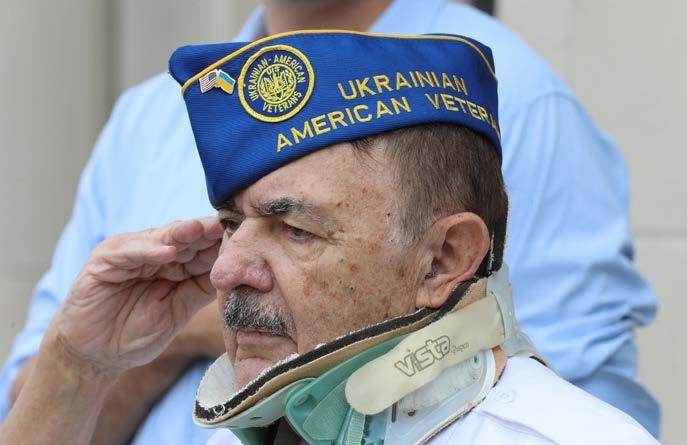
changed. Ukrainian JC still looks to promote Ukrainian culture in Jersey City, but first looks to help save it in its homeland overseas.

“We have a few projects that we took on since the war,” Oksana said. “When the war started, we took on the project of humanitarian aid, which included sending cars, ambulances, tourniquets, uniforms, wheelchairs and more. We also help two orphanages, and two elderly homes. We helped build a bomb shelter for kids for the orphanage.”
Back in Jersey City, the organization is helping refugees who were able to flee the war in Ukraine. The Refugee Project Manager is Tamara Syby, who coordinates how Ukrainian JC helps each refugee.
“Many people left with nothing and came here,” Oksana said. “It was also a few waves of the way people were coming here. The way people were getting out of war, it was very difficult. The airports were closed on day one and they were heavily bombed by the Russians. I don’t think American readers understand what it means to be under occupation. People don’t understand how hard it is to get out of those areas and how lengthy the process can be and how dangerous.”
Oksana said many were affected by the war overnight. The Russian invasion changed their entire lives in an instant, causing them to eventually flee.
“People were sleeping calmly and then the army just stormed in,” Oksana said. “They went to bed in Ukraine and they woke up under occupation of Russia. Their soldiers are ruthless. So people were staying in bomb shelters and bunkers not coming out because they would be murdered. The Russians would track their phones
and everything. It’s very dangerous to be in an occupied zone. Civilians don’t belong there. They’re there just as a human shield.”


The horrors of the war in Ukraine underscore the importance of the work that Ukrainian JC does. Oksana said the organization began helping Ukrainian refugees just days after the Russians invaded, and they continue to come in waves.
“The refugees left with nothing and they were living peaceful lives,” Oksana said. “They come here with nothing. People started coming around March 1. I feel we started to get our first arrivals then, which is like six days after the war started. That was the people who were closer to the border at that time. We did not know how soon and what was going to happen, and there was a fear that Kyiv would fall really quickly.”
Many of the refugees who flee Ukraine are women and children. The husbands and fathers often stay behind, taking up arms to defend their country against Russia.
“We have a lot of mothers with children, because the husbands are there fighting the war,” Oksana said. “So that’s the hardest part. It’s enough that they’re coming by themselves, but they have to take care of the kids also. Then you have schooling, and you have medical health records that you have to do for schooling. It’s very difficult just to provide.”
Oksana’s family made up some of the refugees fleeing Ukraine in March. They had previously visited her in Jersey City during the summers before fleeing the war.
“I have sisters who are 13 and 14,” Oksana said. “The only reason why my family decided to come is because of them. At that time, we were fearing for them not to get raped and killed by Russians. That was a very straightforward possibility, considering what was and is still happening right now in our country. I had family that traveled by river to get out at night so they’re not killed. It’s surreal.”
While many refugees were arriving in March, the United States did not open the applications for Temporary Protective Status (TPS) for refugees until April, when President Joe Biden extended TPS for Ukrainian refugees preventing them from being deported and helping them find work. Until then and even afterward still, many people who fled Ukraine are left to survive off the donations of organizations like Ukrainian JC and the Ukrainian National Home.
“People were living here, just off volunteers helping out,” Oksana said. “That was purely it. They had no food and no shelter. They were coming, either to relatives or friends, or volunteers were offering up their places to stay.”
Oksana was encouraged by the outpouring of support for Ukraine and the refugees fleeing the Russian invasion. She said many refugees were just like Jersey City residents, only now forced to find their way in a new country after the Russian invasion.
“I was hoping they would help,” Oksana said. “We are all immigrants here at the end of the day, besides the Native Americans. We live on one planet, so for us to
get along and to help each other, this is the way. We have to work with each other. And these families, they are bringing very good knowledge. A majority of them are very well educated with a great work ethic and incredible people.”
If a Ukrainian refugee arrives in Jersey City, and they are looking for help, they can reach out to Ukrainian JC. The first step for any refugee is to fill out a Google Form about themself, which the nonprofit uses to assess how they can help.

“The first step is to fill out the Google Form providing information about themselves, like who did they arrive with and when, and what their immediate needs are, as well as any contact information,” Oksana said. “Then we contact them and we talk to them. After that, we determine how we can help.”
In addition to helping provide food, clothing and other necessities, Ukrainian JC helps provide refugees with a number of other vital services. This ranges from health clinics to attorney clinics to educate refugees on how to fill out the proper paperwork and what to do with it afterward.
“We have two lists, a needs list and a volunteers list,” Oksana said. “So people volunteered their homes, their clothing, their food, their pro bono help attorney services, their pro bono help with medical services. That’s what we needed, their pro bono help, to get kids in schools. That was super difficult because kids came at the end of the year and to get them into school was hard.”
On top of that, perhaps the most important thing Ukrainian JC does is help refugees without a place to stay find a host family. The organization is assisting about 146 families in various ways right now.
“Each family has different needs,” Oksana said. “Some people if they come to family or friends, they don’t have a need for housing. I mean, they still do in the sense that everybody wants to have their own place, because some people are literally living on couches in people’s houses. For each person, the level of help depends on their needs. But we try to help all of them. Some people just need guidance, like where to go, who to talk to, and pro bono legal help.”
Using their connections, Ukrainian JC was able to secure charity care for some refugees at RWJBarnabas Health Jersey City Medical Center and pro bono legal
services from the City of Jersey City. Oksana said the city has been very helpful assisting the nonprofit in aiding refugees, even welcoming some to the city when they arrived in April with bags of supplies.
“Jersey City was and continues to be very generous and very helpful,” Oksana said. “We will continue to engage people here and will continue doing so until we’re done with this terrible, terrible war.”
According to Oksana, Ukrainian people are very loyal. She said that one day, they will hopefully be able to return the favor.
“If you help Ukrainians, they will help you down the line,” Oksana said. “I am very thankful for people who did not turn their shoulder away. I really am appreciative of the people who stepped out of their comfort zone and wanted to help.”
Part of that may be because Jersey City has a large Ukrainian population. However, the support for refugees fleeing the war has come from diverse groups of people.
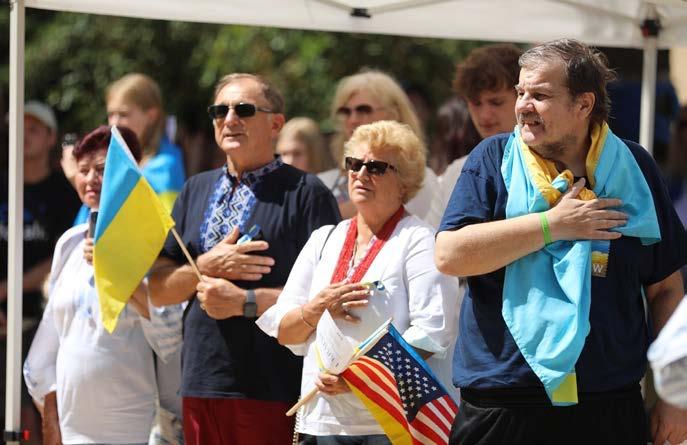
“Most people who live in Jersey City know at least one Ukrainian,” Oksana said. “Once you know a Ukrainian and our culture, we typically create relationships and are very open and warm people. In Jersey City, immigrants from Ukraine came all the way back in 1918, after World War I. The Ukrainian National Home just celebrated 100 years. That’s a long time that Ukrainians have been here. But I think the reason why people helped truly is because we have a very diverse city. Because of that, we have people from all over the world. Those communities have experienced trouble from Russia and their invasions. They’ve been donating and bringing clothes. From all over, we felt like it was all the communities that have offered help. Because we’re so diverse in here, and
people have troubles in their own countries and their own homes, that’s why it’s united us for a better future.”

Oksana reinforced that Ukrainian JC and the Ukrainian National Home would continue to support Ukrainians abroad, refugees in Jersey City, and all those impacted by the Russian invasion as long as the war goes on. Even as the war changes, they will still be there to fill the need, and to keep the cause present in everyone’s thoughts, having held rallies and town halls in the past supporting Ukraine.
“We are continuing our efforts into the future,” Oksana said. “The war is changing, and this is super important for us to continue to talk about until this is over. Right now, we’re winning. So we really need support more than ever right now to get this job done and to free the occupied parts of the country. If we lose, God forbid, Georgia, Belarus and all these other countries are just going to vanish.”
At the end of the day, most Ukrainians want to go back to their home country and rebuild. They long for a victory over Russia to return to their lives in peace.
“A lot of the families want to go back home,” Oksana said. “They want to go back home to their families. So keep on supporting us, because we have to make sure that the world is for good people and not evil.”
For refugees looking for help, email Ukrainian JC at info@ukrainianjc.com. The same applies for residents seeking to donate to or volunteer with the nonprofit.
— JCMKim Correro, Dawn Giambalvo and Lorraine Freeney are the coleaders of the Hudson County Chapter of the statewide nonprofit Native Plant Society of New Jersey (NPSNJ). The three Jersey City residents are on a mission to educate locals about the benefits of native plants and provide access to them across the county.
Speaking with Jersey City Magazine, Kim and Dawn stressed the importance of native plants in the environment. Planting foliage whose native habitat is Hudson County is highly beneficial for a number of reasons, primarily helping wildlife and even other plants.
“Native plants are the plants that have adapted to our local conditions and our local flora,” Kim said. “They are important because they provide sustenance to our local birds, butterflies and other pollinators. If we don’t have these plants to provide them with the food and the nourishment that they need, then we won’t have pollinators to pollinate our other gardens, our vegetable gardens and our crops.”











Native plants serve as a highway for nature on top of providing sustenance. The native fauna and flora allow for the easier migration of a number of species, including birds and insects, among other wildlife.


“Native plants provide a way for wildlife to travel through, past and around our area,” Dawn said. “We’re on two different flyways, with that intersection making New Jersey one of the birding capitals of the world. People forget that this is what’s going on. The natural world is doing its thing, it’s moving and grooving. And if we add native plants wherever we possibly can, even in little curb strips, or in pots on patios in front of someone’s stoop, those become microhabitats. When you link all these microhabitats together, it allows insects, birds and other
wildlife to migrate naturally through the area. So it’s more than just plants, it’s a highway.”





Native plants also have more seeds, meaning they will provide that sustenance for wildlife more so than non-native plants. The native greenery also needs less care, making them easy to take care of, especially in an urban environment such as Jersey City.

“They require less water, less maintenance and no chemicals,” Dawn said. “You don’t have to hire someone to go out in your yard and spray fungicides, herbicides or pesticides. Native plants have the deepest roots, they support more insects and wildlife, they absorb tons of stormwa-












ter to help mitigate flooding, and they help ward off the effects of climate change. They sequester a ton of carbon, even more so than trees. It’s not just hip or cute to plant native plants, it’s necessary.”
The planting of non-native plants is already affecting the local ecosystem throughout Hudson County. Kim and Dawn highlighted that every plant can make a difference.
“Hudson County is very densely populated,” Kim said. “There’s a lot of development in about every area of the county. The plants are losing this very important battle to all of the development that’s going up. Development is great, but we’re losing our trees and our plants. Because of that, we’re losing our bird population. And we just heard that the Monarch caterpillar is now on the endangered species list.”
While native plants are wonderful for the environment for a number of reasons, they are not easy to come by. As such, the Hudson County Chapter of the NPSNJ holds two plant sales each year to ensure native plants are readily available for residents across the county.
“The sales are very special because the closest native plant nursery is like an hourand-a-half drive away,” Kim said. “Native plants are so hard to access here.”
At the sales, there are experts from fields related to native plants. Dawn said this ranges from composters to nursery growers.
“The plant sales that we have are at zero profit,” Dawn said. “This is purely a community service. It’s also educational. The vendors and people that are attending our plant sale coming up are at the height of their field. We have these people there because we want the average person to be able to approach them and ask questions. I tend to be one of the people that learns most through my human interactions and I feel like this is an opportunity for people to just walk up and get a primer very quickly on the importance of native plants.”
For those who didn’t catch the fall plant sale, there will be another in the spring, al-
though the fall is the best time to shop for and plant native plants.


“We aim to do two major plant sales a year,” Kim said. “We have one in the spring, but the most important one is in the fall. It’s important for people to understand what a good time of the year it is to start planting and do the majority of your planting.”
“Most of us think about planting in the spring because flowers are blooming and we’re excited to be outside after a long winter, but fall is an important planting time.” Dawn said. “That’s why this is an even more important plant sale than the spring one. When native plants are planted in the fall, it’s a special time because the temperatures are a little cooler, so there’s less of a stressor on plants. If you plant earlier in the year, it gets hot here very quickly and some plants have to struggle
through the dry summer wind. But planting in the fall, it sort of eases the plants into the ground. And I think they just have an easier time of it. In fall, the native plants are able to make those deep roots and connections. They grow throughout the fall up until really cold snap temperature. And with climate change, we don’t have these super-cold temperatures until the middle of December into January.”
Native plants are not only hard to acquire, so is land dedicated to plant them. In addition to getting native plants in the hands and yards of residents, the organization is working with municipalities on getting them into parks. The Hudson County Chapter has worked with Jersey City
and local organizations focusing on pollinator paths and other endeavors in Lincoln Park.
“One of our goals is to create greenways throughout Hudson County, not just for people to walk on, but for animals to migrate,” Dawn said. “Jersey City has the capability of becoming a pollinator city one day soon. It’s just starting to be on the radar.”
In Lincoln Park West, the group has been focusing on restoring wildlife and the forest there. Work has been ongoing since last year, with more work to be done, but signs of progress are already showing.

“Our chapter has really concentrated on large projects,” Kim said. “For the project in Lincoln Park, we’re working with the Friends of Lincoln Park on the West Side to restore the habitat. It has really been taken over by invasive plant species. It’s a big project, but we have a lot of help. We’re now a year into it, and it’s beautiful to see what we’ve accomplished. But there’s still a really long way to go and a lot of work to do.”
Outside of Jersey City, the group is working on a new park with Secaucus known as the Imagine Garden. Hudson Regional Hospital is across the street diagonally, so the town’s concept was to create a space for people either visiting someone in the hospital or admitted there to go and sit with their loved ones.
“It was last May or even earlier than that, when they said: ‘We have this ballfield. Would you like to make a park out of it?,’” Dawn said. “So we had the opportunity to turn an old, empty soccer field into this beautiful ecological park that is wheelchair accessible. It’s become this magnificent project.”
Amid the many native plant gardens at the park, there will also be 50 vegetable garden beds, and a sensory garden. In addition, the park will feature wheelchair accessibility,
pervious paths and rain gardens to absorb stormwater, and places of respite in the park to encourage community interaction, all courtesy of local NPSNJ volunteers.
“It’s amazing to see how far it’s come, but also how far we still have to go with it,” Kim said. “One thing about native plants is you put them in the ground, and sometimes they take a year or two to really establish. So we are a year in, and I really look forward to seeing what happens now in this next stage.”
More fall plantings are slated for the gardens in the coming weeks, as native plants are now being delivered to the park. The hope is that these endeavors by the NPSNJ will spark interest and more initiatives in the future.
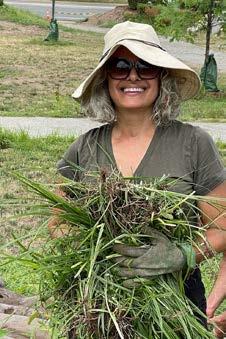
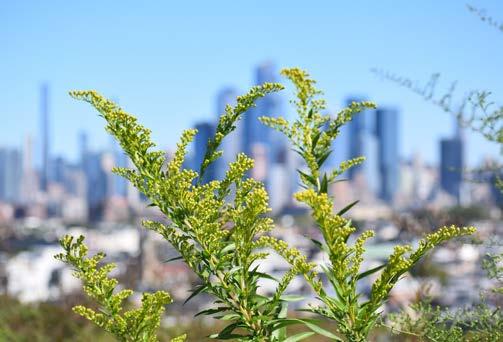
“The big projects are hopefully going to encourage smaller projects,” Kim said. “We already do a lot of work with schools, we volunteer with Girl Scouts, and we’re hopefully going to be doing something with the Boys and Girls Club this fall. Wherever we can provide that education and whoever is willing to listen, then we are going to be there.”
Outside of the plant sales and park projects and other events across the different municipalities, the Hudson County Chapter of the NPSNJ has also launched a weekly poetry series with a Jersey City poet. Known as Saturday Morning Poetry with Ann Wallace, the idea grew from Kim initially posting a single poem by Ann on the NPSNJ’s Instagram. Follow them at @ kimcorrero and @annwallace409.
“It started in the early summer because I’m a poet and Kim asked to share one of my poems,” Ann said. “Then she wanted to share another. Then we thought, well, there’s so much poetry out there, and
then at the same time Ada LimÓn was appointed the Poet Laureate of the United States. She writes a lot about nature and wildlife and native plants, so that week I told Kim that I wanted to post this poem by Ada Limon. Once we did that, the wheels started turning for both of us, that we wanted to bring in a different poet and a different poem every week. That’s what happened, and we just ran with it.”
Ann used her connections to poets across the country to bring in new material to post on the NPSNJ’s Instagram page. Soon, the posts turned into Instagram Live poetry readings every Saturday.
“We’ve had a few Jersey poets, but we’ve had people from all over the country who’ve sent in their work,” Ann said. “We posted it, and then early on I decided to read one of the poems on Instagram Live. Then Kim suggested we invite the poet to
have a reading and interview with me on Instagram Live. So it evolved very organically. We just started small with one poem on a day, like one of my poems on Saturday, and then we just built from there and kept thinking bigger and bigger. It’s now become this weekly feature. By the time we’re going to be wrapping up mid-October, we will have had 12 different guest poets for Saturday morning poetry, each with an Instagram Live or Zoom interview.”
According to Ann, the readings also include interviews with each poet afterward. Guests included: Ross Gay, Maggie Smith, Julie Zickefoose, Rachel Mackow, Theta Pavis, Thomas E. Frank, Barbara Kingsolver and Lili Taylor. Season one has ended, with the videos still available to watch on Instagram, and season two is planned for the spring.
“It’s not so much an interview as a reading by the poet and then a conversation,” Ann said.” These conversations have been really very rich, and in some cases complex, but they’re also just reflective. We slow down and we listen to a poem together. How many times do people get on social media and listen to poetry? Not that often. So this invites people to slow down, stop, listen, think, and then also take those ideas home with them and out into the world.”
Ann said the poems all revolve around nature, but from the perspectives of different authors in different environments from urbanites to farmers. Nature has had a profound impact on many poets, and the series aims to highlight that and demonstrate that native plants are an important aspect of that.
“One of the things that keeps coming up again and again in these conversations is about walking, observing and getting out into your environment,” Ann said. “Every poet has been a keen observer of their environment, whether they’re a native plant gardener, or a birdwatcher, or just a person who may be a parent who’s watching their kids grow up and seeing that reflected in the life cycle of the birds or the plants around them. The metaphors that nature holds are rich and meaningful. That’s what we’re

trying to invite people to experience with us.”
Another effort undertaken by the Hudson County Chapter of the NPSNJ was participation in the Hudson Gives campaign back in May to help fundraise for more native plantings. The local chapter helped raise funds to plant native greenery in 10 projects at school gardens, public gardens, parks and more.

The “mini-grants” were awarded by the Hudson County Chapter to other organizations and people who are restoring small patches of land in their communities. Some projects included planting native flora and fauna at Triangle Park in Greenville and West Slope Community Gardens in the Heights, which the co-leaders personally attended to get their hands dirty helping to plant.
“We’re not just ladies who have lunch or anything like that,” Dawn said. “We actually get dirty. We get filthy and dig and work really hard. It’s all worth it.”
In addition there are also online webinars hosted frequently by the NPSNJ. For more information, go online to npsnj.org.
“The Native Plant Society of New Jersey has an incredible webinar series started during the pandemic,” Kim said. “It’s a bunch of chapters

coming together and we have some of the top leaders of scientists, botanists and entomologists that come on and talk to us. Hundreds of people watch and attend these webinars for the advice.”
Kim noted that all of the benefits of being a member of the NPSNJ come at an affordable price. She said that membership offers residents the ability to continue to learn about native plants and help promote them in the area, as well as any other chapter they so desire.



“For $20 a year, you have access to our incredible team of scientists, you can go to all our events if you want to, you can get onto our webinar series for free,” Kim said. “All of the other organizations are fantastic, but we’re the only organization that I’ve come across where they don’t charge more than that to give all of these services. Even when you volunteer at one of our events, you’re learning and that is what people come for. We give away a lot of pizza, too, most of the time, but the chance to be around these other people who know about the plants and how they’re changing our world is what people come out for.”
Together, the Hudson County Chapter aims to save the environment one plant at a time. For more information, email Hudson@npsnj.org or follow them on Instagram at @npsnjhudsoncounty.
Kim confirmed: “One of our primary functions as a chapter is being able to resource the plants and bring them to the people. They are hard to get to. You have to drive pretty far from Jersey City and Hudson County to go to a native plant nursery. So educating people, broadening our audience through poetry, and in some cases art, is really important. Having these different verticals, I think, sets the Hudson County Chapter of the Native Plant Society of New Jersey apart.” — JCM

Jersey City has changed a lot over time, but Laico’s has remained mostly the same for 50 years. The restaurant is a red-sauce joint hidden away in a residential section of Greenville.
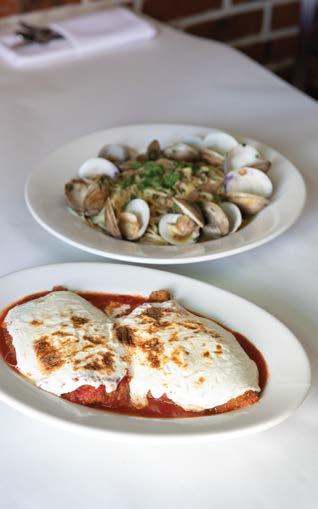

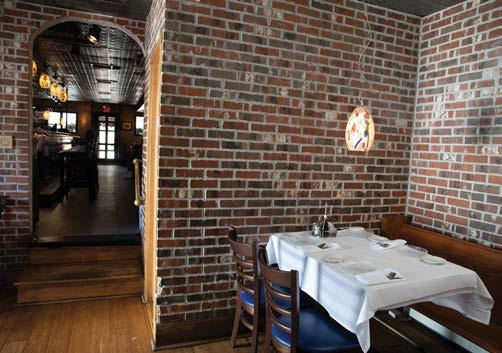
“When you come here, you’ll get about halfway down the block and think there’s no way there’s a res-











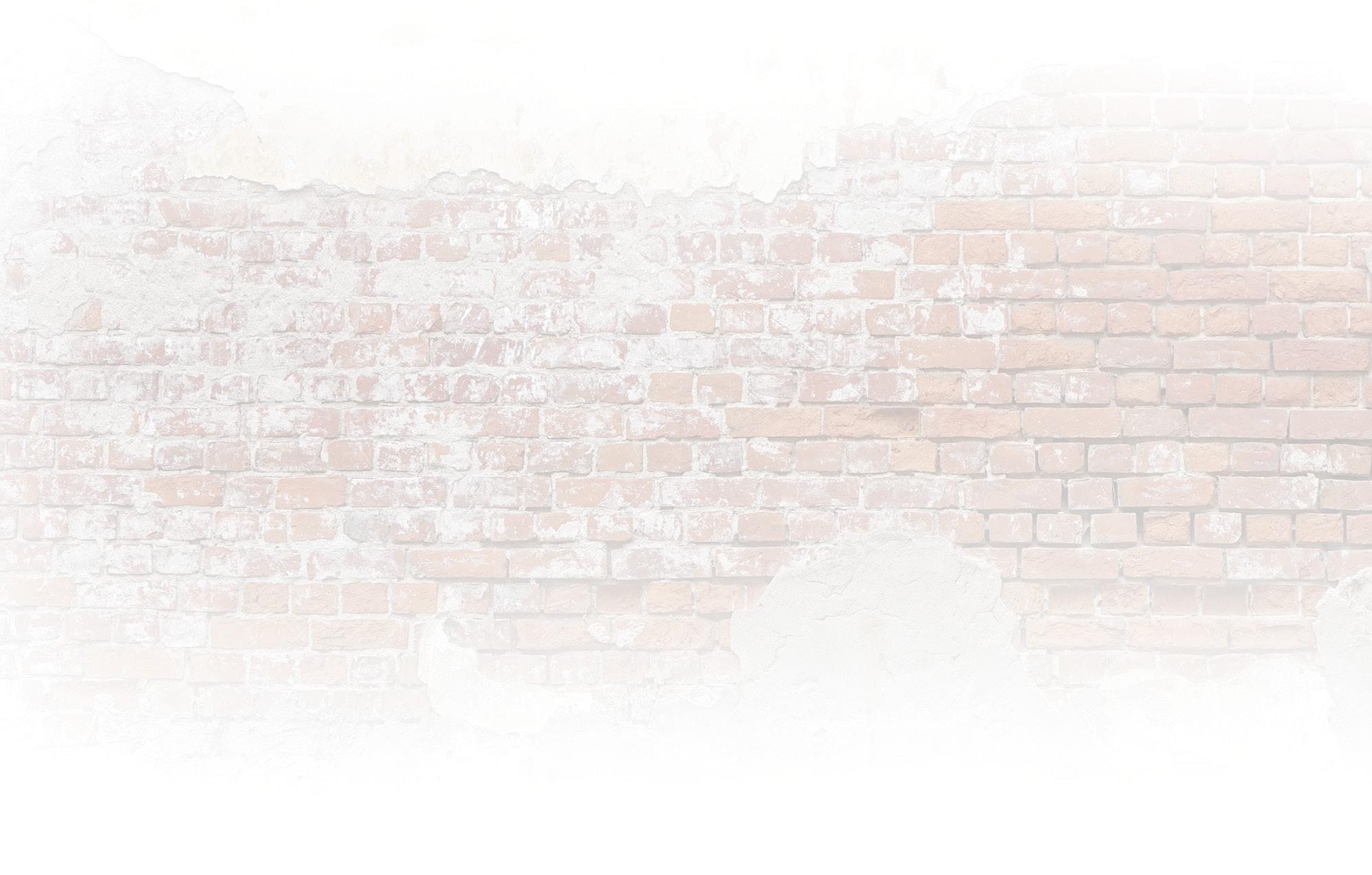
taurant over here. They say, ‘Location, location, location.’ But how did they make it all this time,” wonders thirdgeneration co-owner Adam Laico. “Then you walk in, and you’re in somebody’s house, and you get this outstanding food.”

The food is made by Adam’s dad, co-owner Louis Laico, and his kitchen team.



Louis shares the Laico’s origin story.
“My father bought this little bar on a side street. There was shuffleboard right here,” he says, gesturing to the row of tables in the front dining area. “It was just a dive bar. They wanted to be close to the house, which was in Country Village so it was only about half a mile away.”
The family made some repairs and expanded the building by converting the kitchen into a back dining area. They
grew the menu, which focused on bar pies and meatball sandwiches at the time.
“They had a chef in the back, and one day he got sick, so I said, ‘Ok, I’ll do it for a while,’ and I’ve been here ever since. I could’ve done two life sentences and be out a free man by now,” Louis laughs.
He says he credits Laico’s success to his parents, Louis Sr. and Felice Laico. “My dad
was like a promoter. People loved him. He was very personable. He would go into a room, and he would know everybody by the time he left, unlike myself. I was always in the kitchen. I couldn’t be bothered.”

But the kitchen is where the magic happens here at Laico’s
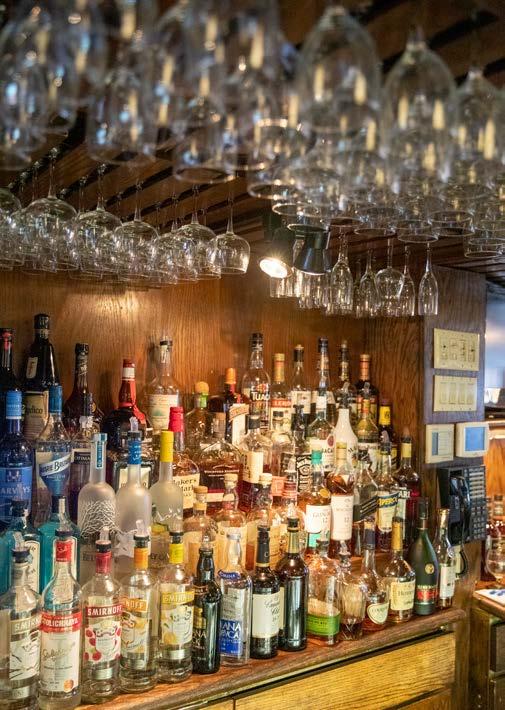
The meal starts with warm bread and salad served family style.
“We make our own bread in-house. It’s a garlic bread,”

ning,” he says. “I believe it translates to ‘cooked on a stick,’ or ‘cooked on a skewer,’ because it’s prepared that way, but it comes out looking like a huge mozzarella stick.”
It tastes like an elevated version of my diner favorite, and it’s big enough to share.
Next, we’re served Grilled Octopus, which is fresh and light, over a green salad.
Then, a Margherita Pizza emerges from the kitchen. It’s so good that it can be a whole
Adam explains. “Every table gets that and a salad with homemade dressing. It’s been the same dressing for years.”
Next is Spiedini Alla Romana. It’s a tasty mozzarella appetizer served with a lemon caper sauce that I thought was their own invention. Adam tells me it’s old-school Italian, just like most of the things you’ll find at Laico’s. “That’s been here since the begin-
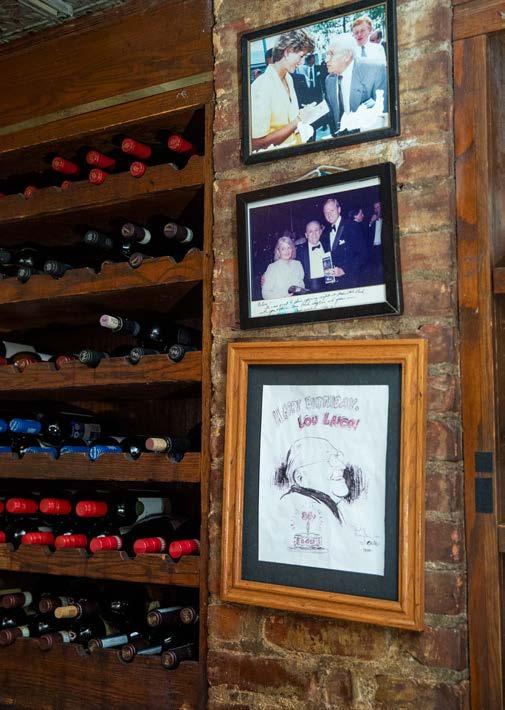
meal, but we haven’t even made it to the entree course.
Louis brings us the Pork Chop, which is my favorite menu item. Louis and Adam aren’t surprised. They tell me it’s a popular dish. It’s gigantic and juicy. It comes with vinegar peppers and mushrooms in a rosemary sauce.
The Linguine with White Clam Sauce is excellent. The pasta portion is generous,
 Adam and Louis Laico
Adam and Louis Laico
and so is the serving of fresh clams.
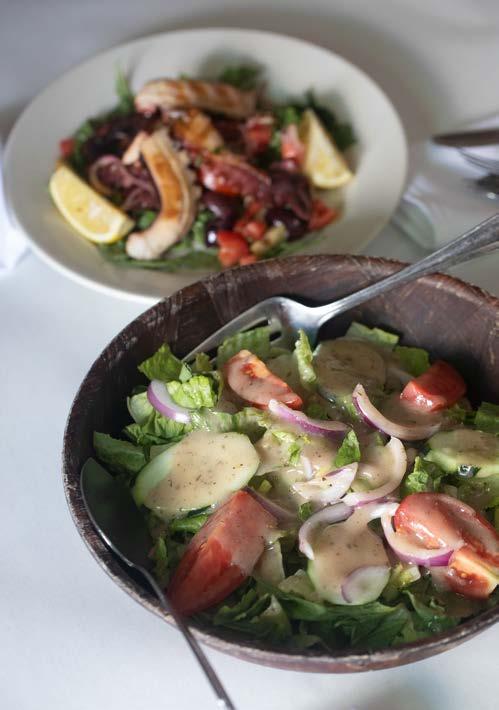
Next up is the fantastic Chicken Parm. It was named the best chicken parm in New Jersey by eatthis.com for 2022. It’s easy to see why.
“I’m going to tell you what sets it apart because I make it,” Louis says. “It’s never breaded ahead of time. When you put the breading on it ahead of time, and you leave it in the refrigerator a day or two, or freeze it, it dries out the chicken. You can cut this chicken with a fork. Every time an order comes in, it’s made fresh to order. We butcher all of our own chicken. It’s not laying in packages.”
They say that after they were ranked No. 1, they had an influx of orders.
“They were waiting outside in line,” Louis says.
“It’s a good problem to have,” Adam adds.
Nowadays, they say that on any given day, the dining room is split 50/50 with regulars and the younger crowd. Folks find their way to Laico’s from downtown, Hoboken and New York City.
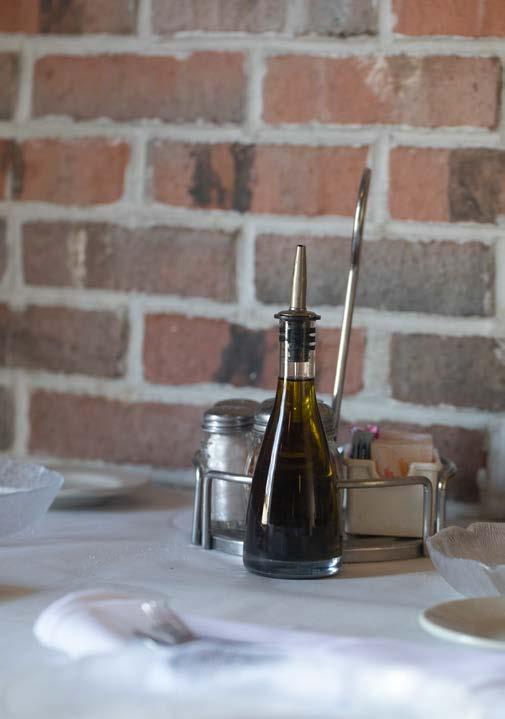

For many who call Greenville the old neighborhood, Laico’s is Jersey City. The free valet parking makes it convenient to visit.
“A lot of people who have moved out of the area, when they come back to Jersey City, they pop in,” Adam says.
“It’s a neighborhood spot that’s stood the test of time. It’s nostalgic, especially in a city that’s changed so much.”
— JCM



Check out our Weekend Special Hawawshi, and Saturday Special Koshary, Daily Lunch Combo Specials, Falafel and Hummus, with our homemade Harissa Hot Sauce, as well as the Mixed Grill and Lamb Chops!!




Moudy Razek was schooled in the culinary arts in London, Cairo, and the U.S., and has worked in, managed, and owned some of the nest restaurants across the world - The Rainbow Room in NYC, The Sphinx Grill in Amsterdam, Lantana Restaurant and Doc’s Steakhouse right here in New Jersey.

It was in these places that he learned to use the nest, freshest ingredients to create mouth-watering, delicious dishes designed to appeal to everyone from vegetarians to devout carnivores! Moudy’s time spent abroad has infused his culinary creations with a unique European/Mediterranean air that also displays more than a hint of Middle Eastern sensibility.
O ering high-quality food at reasonable prices, Gypsy Grill will likely become a favorite with your family or coworkers.















